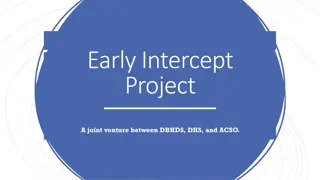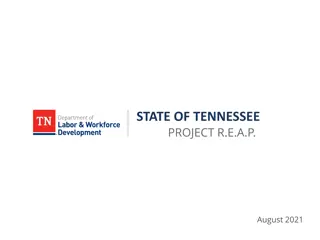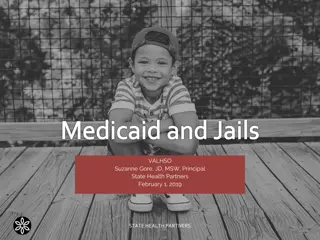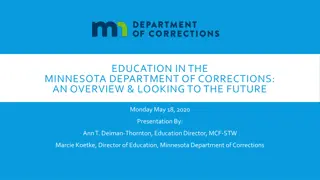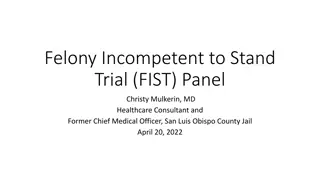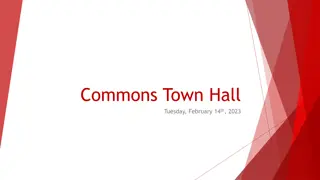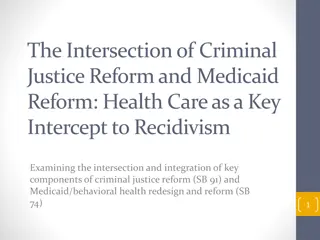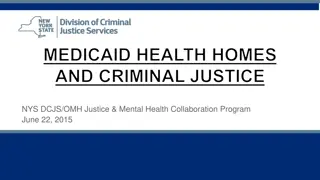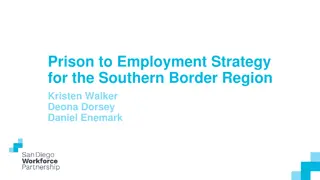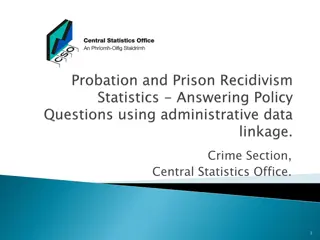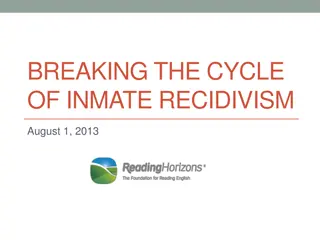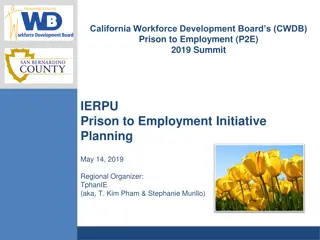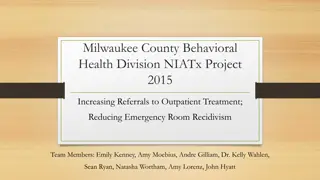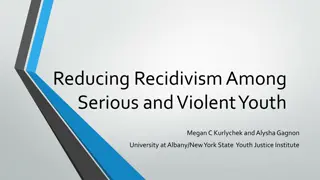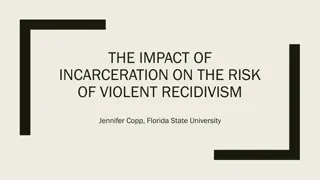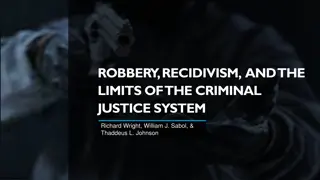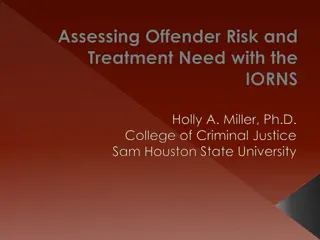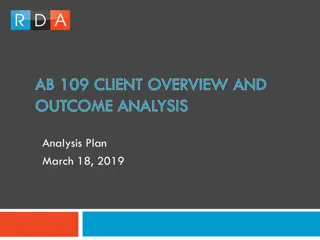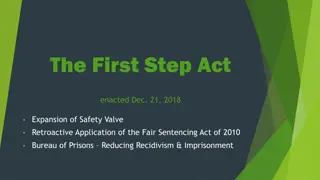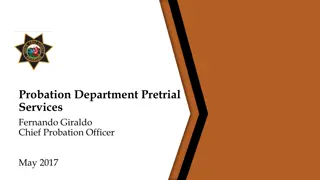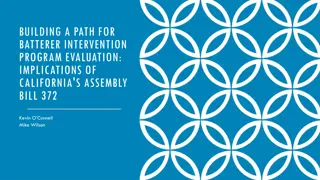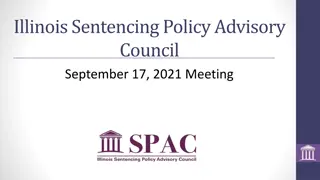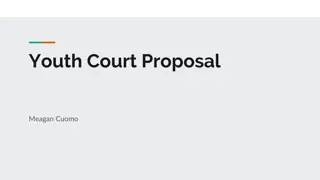Early Intercept Project: Enhancing Mental Health Services in Arlington County
The Early Intercept Project is a collaborative effort between DBHDS, DHS, and ACSO aimed at improving mental health services in Arlington County. Key objectives include reducing ECO recidivism, integrating PBMP and FDP programs, and enhancing discharge planning for clients in state hospitals. Throug
0 views • 11 slides
Addressing Recidivism through Project R.E.A.P. in Tennessee
Statistics in Tennessee show a high rate of recidivism among offenders, highlighting the need for effective re-entry programs. Project R.E.A.P. focuses on providing education, training, and post-release support to reduce the likelihood of re-arrest and incarceration. The program offers resources lik
0 views • 9 slides
The District Court Reentry Project (DCREP) in Baltimore City
The District Court Reentry Project (DCREP) was initiated by Judge Nicole Pastore Klein in response to the lack of employment opportunities for individuals with criminal records in Baltimore City. The project aims to assist ex-offenders in finding educational and job placement opportunities by collab
0 views • 21 slides
Importance of Medicaid in Jails: Enhancing Healthcare Access
State Health Partners focuses on improving healthcare access for individuals with limited resources or complex needs, especially within the context of Medicaid and jails. Medicaid plays a crucial role in supporting jails to provide healthcare services, impacting cost savings, improved health outcome
0 views • 14 slides
Overview of Education in Minnesota Department of Corrections
Explore the education programs offered at the Minnesota Department of Corrections (DOC) facilities, their mission, vision, and values, as well as future opportunities for offenders. The DOC aims to reduce recidivism through secure incarceration and community supervision, contributing to a safer Minn
0 views • 12 slides
Ensuring Mental Health Care in San Luis Obispo County Jail
Healthcare initiatives in San Luis Obispo County Jail aim to improve mental health services, focusing on FIST patients and reducing recidivism. Efforts include the Stepping Up Initiative, JBCT programs, and partnerships with DSH for support.
0 views • 9 slides
Specialty Courts and Recidivism Rates in the United States
Specialty Courts, such as Drug Courts and Problem-Solving Courts, provide intensive behavioral supervision and treatment for substance abuse and mental health issues. These courts aim to reduce recidivism rates and engage criminal offenders in therapeutic interventions. Nevada is actively running 42
1 views • 14 slides
Reentry Court District of Minnesota Overview
The Reentry Court in the District of Minnesota focuses on reducing recidivism among moderate/high-risk offenders through a collaborative effort between various agencies. The program offers a structured 12 to 18-month supervision period, emphasizing court attendance, stable residency, employment, and
0 views • 12 slides
Understanding the Veterans Treatment Court: A Path to Rehabilitation
Veterans Treatment Courts offer a specialized approach to help justice-involved veterans with substance dependency or mental health issues while balancing community safety. These courts aim to reduce recidivism, provide tailored support, and promote personal responsibility. By focusing on treatment
0 views • 17 slides
Eighth Judicial District Specialty Court Programs in Clark County
Eighth Judicial District Specialty Court Programs in Clark County serve 1200-1500 residents annually with various programs such as Substance Abuse Treatment, Adult Drug Court, DUI Court, Juvenile Drug Court, and more. Established in 1993, these programs aim to improve public safety, reduce criminal
1 views • 10 slides
Analysis of Bail Reform Effects on Recidivism and Felony Arrests
This content discusses the impact of bail reform on recidivism rates and felony arrests, comparing outcomes between posted bail and $0 bail scenarios. Through the analysis of images depicting recidivism trends and felony arrests post-bail release, insights into the effectiveness of different bail sy
0 views • 5 slides
Building the Complete Kairos Community: Unity, Listen, Love
Explore the transformative mission of Kairos Prison Ministry International in building a community based on unity, listening, and love. Through various programs and events, Kairos aims to support those incarcerated, their families, and all impacted by incarceration, fostering openness, opportunities
0 views • 19 slides
Understanding AB 109/117 Public Safety Realignment
AB 109/117 Public Safety Realignment, implemented in California, shifted the responsibility of specific felons to county control, established Post-Release Community Supervision, and introduced new sentencing schemes. It addressed misconceptions about early release and custody transfer from state pri
0 views • 43 slides
Idaho's 24/7 Sobriety & Drug Monitoring Program Overview
Idaho's 24/7 Sobriety & Drug Monitoring Program, led by Program Coordinator Tami J. Faulhaber, aims to reduce recidivism, improve public safety, and act as an alternative to incarceration. Participants undergo regular testing and supervision, enabling them to live soberly in their communities while
0 views • 16 slides
The Intersection of Criminal Justice Reform and Medicaid Reform: Health Care as a Key Intercept to Recidivism
This study examines the integration of criminal justice reform (SB 91) and Medicaid/behavioral health redesign and reform (SB 74) in Alaska. It highlights the history of SB 91, the problems faced by the state's prison system, findings from data analysis, and the impact of SB 91 in reducing the inmat
1 views • 45 slides
Intersection of Medicaid Health Homes and Criminal Justice: Collab Program
Addressing the intersection of Medicaid health homes and criminal justice, the program aims to provide access to healthcare for justice-involved individuals, supporting recovery and meeting shared goals for better health, public safety, and reduced recidivism. The initiative involves collaborative e
0 views • 48 slides
Exploring Alternatives to Imprisonment in Criminal Justice Systems
Delve into the world of alternatives to imprisonment as a means of reformation and rehabilitation for offenders. Discover how various countries like Canada, Fiji, India, and Malaysia are implementing innovative approaches such as community rehabilitation centers, parole systems, and probation progra
0 views • 11 slides
Prison to Employment Strategy in Southern Border Region
This presentation focuses on the prison to employment strategy for the Southern Border Region, highlighting statistics on incarceration rates in California, specifically San Diego and Imperial Counties. It addresses recidivism rates, supervised populations, and measures of recidivism for state priso
2 views • 7 slides
Understanding Mental Health in Custody: Challenges and Approaches
Mental health challenges in custodial settings manifest through a higher prevalence of disorders, addiction issues, and learning difficulties. Research highlights the complexities faced by individuals with co-existing vulnerabilities such as unstable housing, trauma, and limited life skills. Recogni
0 views • 18 slides
Understanding Recidivism Measurement in Criminal Justice Policy
Recidivism, a key measurement in criminal justice policy, is crucial for assessing the effectiveness of rehabilitation schemes over time. This content delves into the challenges of measuring recidivism, different country definitions, the importance of studying recidivism, factors influencing recidiv
1 views • 13 slides
Addressing Inmate Recidivism Through Literacy Education
Over half of inmates in American prisons struggle with low literacy levels, hindering their chances of successful reintegration into society. Providing effective literacy instruction can significantly reduce recidivism rates. Challenges such as varied reading levels and limited resources need to be
0 views • 11 slides
Enhancing Programs for High Needs Population: A Closer Look at Rehabilitation Efforts
In response to the demand for effective programming, initiatives aimed at supporting high-needs populations with limited resources are gaining momentum. Strategies such as case management, correctional education, electronic monitoring, and vocational training are being implemented to address various
0 views • 10 slides
California Workforce Development Boards' Prison to Employment Initiative Summit 2019
California Workforce Development Boards (CWDB) organized the Prison to Employment (P2E) Initiative Summit in 2019 to focus on improving employment outcomes for the reentry population to reduce recidivism. The initiative aligns training, education, and services for this population with regional indus
0 views • 9 slides
Milwaukee County Behavioral Health Division NIATx Project 2015 - Improving Patient Referrals and Reducing Recidivism
The Milwaukee County Behavioral Health Division NIATx Project 2015 focused on increasing referrals to outpatient treatment and reducing emergency room recidivism by improving patient hand-offs to Access Clinic. By implementing same-day or next-day appointments and enhancing communication systems, th
0 views • 6 slides
Fresno County Probation Adult Compliance Team (ACT) Overview
The Multi-Agency Adult Compliance Team (ACT) in Fresno County was established to provide intensive supervision and evidence-based practices for offenders under probation, post-release community supervision, and mandatory supervised release. By collaborating with local law enforcement agencies, the t
0 views • 8 slides
Shine Women's Mentoring Service: Supporting Women in Scotland's Health and Social Care System
Shine Women's Mentoring Service in Scotland provides intensive mentoring to women offenders, helping reduce recidivism and promote compliance with court orders. Strategic drivers focus on non-judgmental listening, empowering women to make positive choices, and ensuring consistent support services. T
0 views • 19 slides
Effective Strategies for Juvenile Recidivism Reduction
Study findings from Palm Beach County highlight significant statistics related to juvenile offenders, such as recidivism rates, mental health issues, and involvement in foster care or gangs. The importance of reentry programs and core principles for reducing recidivism are discussed, emphasizing the
0 views • 22 slides
Understanding and Addressing Serious and Violent Youth Offenders
Exploring various aspects of serious and violent youth offenders, this content delves into strategies to reduce recidivism, the impact of state responses, and pathways to delinquency. It challenges misconceptions, provides definitions, and emphasizes the importance of tailored treatment for such ind
0 views • 23 slides
The Impact of Incarceration on Violent Recidivism: A Comprehensive Analysis
Delve into the complex relationship between incarceration and violent recidivism, exploring theories, prior research findings, and the potential for heterogeneity in the effects of imprisonment on reoffending. Recognize the significance of understanding the impact of incarceration on reducing violen
0 views • 10 slides
Understanding Robbery, Recidivism, and the Criminal Justice System
Exploring the complex dynamics of robbery, recidivism, and the limitations of the criminal justice system through the perspectives of individuals involved in criminal activities. The images and quotes provide insight into the challenges faced by offenders in breaking the cycle of crime and the socie
0 views • 16 slides
Assessing Offender Risk and Treatment Needs with IORNS
The Inventory of Offender Risk, Needs, and Strengths (IORNS) is a comprehensive tool developed to assess variables related to recidivism. It aims to detect possible changes in these variables through treatment, providing a brief and efficient risk/need assessment with a low reading level. The IORNS
0 views • 33 slides
AB 109 Client Overview and Outcome Analysis for Criminal Justice Reform
This analysis plan delves into the overview and outcomes of AB 109 clients, focusing on the population characteristics, service utilization, and recidivism outcomes. It includes a detailed examination of different supervision terms under AB 109 and assesses recidivism based on convictions for specif
0 views • 17 slides
Changes Introduced by the First Step Act of 2018
The First Step Act, enacted in December 2018, brought significant changes such as the expansion of safety valve, retroactive application of the Fair Sentencing Act of 2010, and initiatives to reduce recidivism and imprisonment. Sections like 402, 403, and 404 address safety valve broadening, clarifi
0 views • 27 slides
Santa Cruz County Probation Department Pretrial Services Overview
The Santa Cruz County Probation Department emphasizes public safety, evidence-based practices, and efficient use of jail space through pretrial services. By implementing actuarial risk tools, providing tailored supervision, and utilizing evidence-based techniques, they aim to reduce pretrial detenti
0 views • 22 slides
Implications of California's AB372 on Batterer Intervention Programs
AB372 in California impacts domestic violence programming by providing flexibility in treatment alignment based on batterers' risk levels and introducing evidence-based correctional practices. Risk assessments, comprehensive curricula, and variable treatment durations tailored to risk levels are key
0 views • 23 slides
Judicial Review of GPS Monitoring in Sex Offender Cases
Study sponsored by the National Institute of Justice shows lower recidivism rates for sex offenders on GPS monitoring vs traditional supervision in California. Supreme Court cases like Grady v. North Carolina examined the legality of lifetime satellite-based monitoring, citing Fourth Amendment right
0 views • 23 slides
Circle Peacemaking: A Timeless Practice for Community Justice
In the Circle Peacemaking approach, core community values such as respect, forgiveness, love, family, humor/health, honesty, sharing, and leadership are upheld. Guidelines for the process include confidentiality, equal participation, and respectful dialogue. Community justice benefits include commun
0 views • 9 slides
Illinois Sentencing Policy Advisory Council Meeting Insights
Insights from the Illinois Sentencing Policy Advisory Council's September 17, 2021 meeting include discussions on recidivism costs, fiscal impacts, demographic breakdowns of admissions to IDOC, and analysis of repeat gun offenders' criminal history. The presentation covers data on offenders, non-pro
0 views • 15 slides
Youth Court Proposal for Restorative Justice Program
Meagan Cuomo's Youth Court Proposal aims to offer a restorative justice alternative for nonviolent, first-time juvenile offenders, focusing on offenses like vandalism and truancy. The project involves research, community engagement, and creating connections with local schools to facilitate learning
0 views • 16 slides
Supporting Justice-Involved Youth: S.A.F.E. Team Initiative for Mental Health and Basic Needs
Collaborated by Laurencrest Youth Services Inc. and Youth Probation Services, the S.A.F.E. Team aims to enhance identification and intervention services for justice-involved youth with mental health, addiction, and basic needs issues in the Youth Court. By reducing recidivism, increasing family supp
0 views • 15 slides
